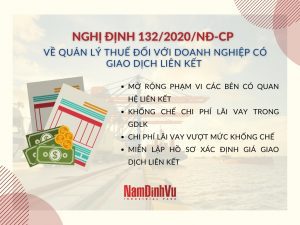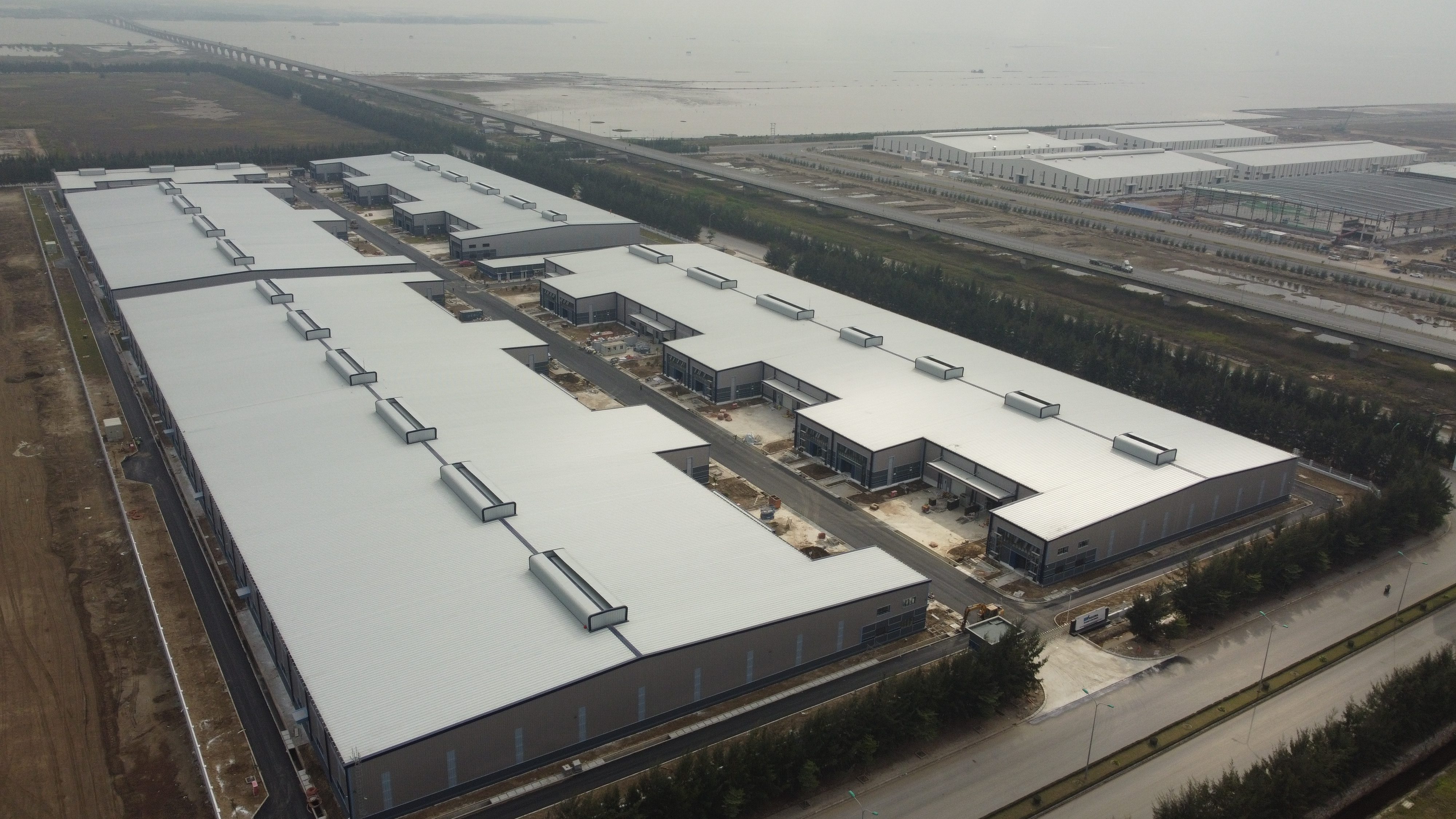On November 5, 2020, the Government issued Decree 132/2020/ND-CP stipulating tax administration for enterprises with associated transactions, replacing Decree 20/2017/ND-CP
The Decree inherits the contents specified in Decree No. 20/2017/ND-CP but in reality there are no problems, only amending and supplementing the missing contents or amending a number of articles to ensure make it clear and transparent.
In this article, we will analyze the outstanding innovations of this Decree 132 compared to the previous Decree 20.

1. Expanding the scope of related parties
Decree 132 stipulates 11 cases where the parties have an association relationship, including:
a) One enterprise holds directly or indirectly at least 25% of the contributed capital of the owner of the other enterprise;
b) Both enterprises have at least 25% of the owner’s contributed capital held directly or indirectly by a third party;
c) One enterprise is the largest shareholder in terms of capital contributed by the owner and holds directly or indirectly at least 10% of the total shares of the other enterprise;
d) An enterprise guarantees or lends capital to another enterprise in any form (including loans from third parties secured from the related party’s financial sources and related financial transactions). similar nature) provided that the loan amount is at least 25% of the contributed capital of the owner of the borrowing enterprise and accounts for more than 50% of the total value of medium and long-term debts of the borrowing enterprise;
dd) An enterprise appoints a member of the management board to operate or take control of another enterprise provided that the number of members appointed by the first enterprise accounts for more than 50% of the total number of members of the management board. operate or take control of a second enterprise; or a member appointed by the first enterprise has the power to decide the financial policies or business activities of the second enterprise;
e) Two enterprises with more than 50% members of the management board or the same member of the management board with the right to decide on financial policies or business activities are appointed by a third party;
g) Two enterprises are operated or controlled in terms of human resources, finance and business activities by individuals in one of the husband and wife relationships; natural parents, adoptive parents, stepfather, stepmother, parents-in-law, parents-in-law; natural, adopted, step-child of a spouse, daughter-in-law, son-in-law; brother, sister, half-brother, half-brother, half-sister, half-brother, brother-in-law, brother-in-law, sister-in-law, sister-in-law of the person of the same parent or half-brother, with a different mother; paternal grandparents, maternal grandparents; grandson, grandchild; aunts, uncles, aunts, uncles and nephews;
h) Two business establishments having the relationship between head office and permanent establishment, or both are permanent establishments of foreign organizations and individuals;
i) Enterprises controlled by an individual through his/her capital contribution to that enterprise or directly participating in the management of the enterprise;
k) Other cases in which the enterprise is subject to the actual management, control and decision on production and business activities of the other enterprise;
l) The enterprise has transactions of transferring or receiving at least 25% of the contributed capital of the enterprise’s owner in the tax period; Borrowing or lending at least 10% of the owner’s contributed capital at the time of transaction in the tax period with an individual operating or controlling the business or with an individual in a relationship as prescribed in Clause 1 of this Article. Point g, Clause 2, Article 5 .
Case l) is 01 newly added case.
2. Controlling interest expenses in associated transactions
Decree 132 still inherits the provisions of Decree No. 68/2020/ND-CP dated June 24, 2020, amending and supplementing Clause 3, Article 8 of Decree 20/2017/ND-CP.
Accordingly, the control of interest expense was increased from 20% to 30% of the total net profit from business activities in the period plus interest expense incurred in the period plus depreciation expense incurred in the period; allows controlling interest expenses after deducting interest on deposits and loans . Regarding the effect: the provisions of Decree 68/2020/ND-CP are applied right in the tax period of 2019 .
3. Interest expense is out of control
Continuing to inherit the provisions of Decree 68/2020/ND-CP amending and supplementing Clause 3, Article 8 of Decree 20/2017/ND-CP, Decree 132 stipulating the portion of loan interest expenses exceeding the transfer control limit . to the next tax period when determining the total deductible interest expense in case the total deductible interest expense of the next tax period is lower than the control level (30% of the total net profit from operating activities ) . business in the period plus interest expense incurred during the period plus depreciation expense incurred during the period). The period of transferring interest expense is calculated continuously for no more than 05 years from the year following the year in which the interest expense is not deductible . Meanwhile, Decree 20 stipulates that the excess interest expense cannot be deducted and cannot be carried forward to the following years.
4. Expansion of the object of exclusion from the application of the limit on deductible interest expenses when determining taxable income
In Decree No. 20/2017/ND-CP, the object of exclusion for the application of the restriction on interest expenses is only (i) credit institutions and (2) insurance business organizations. Decree 132/2020/ND-CP expands to 03 more excluded objects, which are: (i) official development assistance (ODA) loans, Government concessional loans implemented in the form of Government borrowing foreign loans for businesses to re-loan; (ii) loans to implement the national target program (new countryside program and sustainable poverty reduction); (iii) loans to invest in programs and projects implementing the State’s social welfare policies (resettlement housing, housing for workers and students, social housing and public welfare projects) other) .
5. Regulations on submission of the Inter-country Profit Report
5.1. Submission of Inter-country Profit Report when the parent company is in Vietnam
Decree 20 : The supreme parent company in Vietnam with global consolidated revenue in the tax period of VND 18,000 billion or more, is responsible for preparing an inter-country profit report but there is no requirement to pay it. There is no deadline for submitting reports.
Decree 132 : In case the taxpayer is the Supreme Parent Company in Vietnam with global consolidated revenue in the tax period of VND 18,000 billion or more, it is responsible for preparing the Inter-country Profit Report and submitting the Report. report to the Tax Authority no later than 12 months after the end of the financial year of the Supreme Parent Company ;
5.2. File an Interstate Profit Report when the parent company is overseas
Decree 20 : Taxpayers are responsible for providing a copy of the Transnational Profit Report of the Supreme Parent Company in case the Taxpayer’s Supreme Parent Company has to submit this Report to the Tax Authority of the home country. in. In case the taxpayer is unable to provide an Interstate Profit Report, the taxpayer must provide a written explanation of the reasons and legal grounds and cite the specific legislation of the partner country for the failure to comply. allows taxpayers to provide an Interstate Profit Report.
Decree 132 :
TH1: It is not obligatory to submit to the Vietnamese tax authority in the event that the Vietnamese tax authority is able to obtain an inter-country profit report through an automatic exchange of information (“AEOI”).
TH2: Must be paid in the following cases:
(i) The country or territory where the Supreme Parent Company is a resident has an International Agreement on Taxation with Vietnam but no Agreement of the Competent Authority at the time of submission of the Report. ;
(ii) The country or territory where the Supreme Parent Company is a resident has an Agreement between the competent authorities and Vietnam but has suspended the automatic or non-automatic information exchange mechanism; granted to Vietnam;
(iii) Where a foreign corporation has more than 01 subsidiary company in Vietnam, the Supreme Parent Company must notify in writing the Vietnamese tax authority of the subsidiary appointed by the Supreme Parent Company on behalf of the Supreme Parent Company. on behalf of the Supreme Parent Company to submit the Inter-national Profit Report to the tax authority of Vietnam.
6. Exemption from making dossiers of price determination related transactions
In addition to 03 cases of exemption from preparation of transfer pricing documents as prescribed in Decree 20, Decree 132 adds 01 additional case when all three of the following conditions are satisfied:
- Only transactions with related parties are subject to CIT in Vietnam;
- Apply the same CIT rate as the taxpayer (taxpayer);
- Neither party is entitled to corporate income tax incentives during the tax period.
If in Decree 20, taxpayers who satisfy all three conditions above are only exempted from declaration and determination of transfer pricing, then in Decree 132, taxpayers are also exempted from declaration and determination of transfer prices. linked transaction and exempted from setting up transfer pricing dossier.
7. Standard Independent Transaction Range
With Decree 20, the standard independent transaction value range is from the first to the third quartile, equivalent to the 25th to the 75th percentile. With Decree 132, the transaction value range is from the 25th to the 75th percentile . The standard independent translation is the set of values from the 35th to the 75th percentile .

8. Method of comparison and determination of associated transaction price
The method of comparing and determining associated transaction prices in Decree 20 is only briefly specified in Article 7 of the Decree and specifically guided in Circular No. 41/2017/TT-BTC. Meanwhile, up to Decree 132, the Government has stipulated all the detailed provisions on the selection of the comparative method to determine the transfer pricing, as well as the application cases and the principles of application. , the method of determination of each method in Articles 12, 13, 14, 15 of Decree 132.
Above are some notable new points of Decree 132/2020/ND-CP compared to Decree 20/2017/ND-CP. Enterprises in general and enterprises with related-party transactions in particular need to pay attention to be able to properly comply with regulations on tax administration from December 20, 2020, when Decree 132 takes effect.




